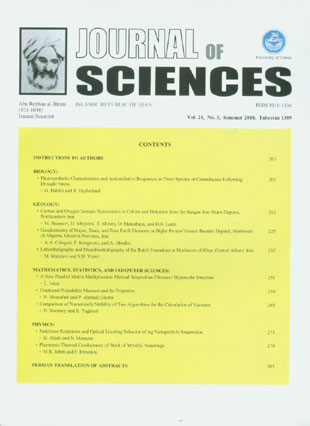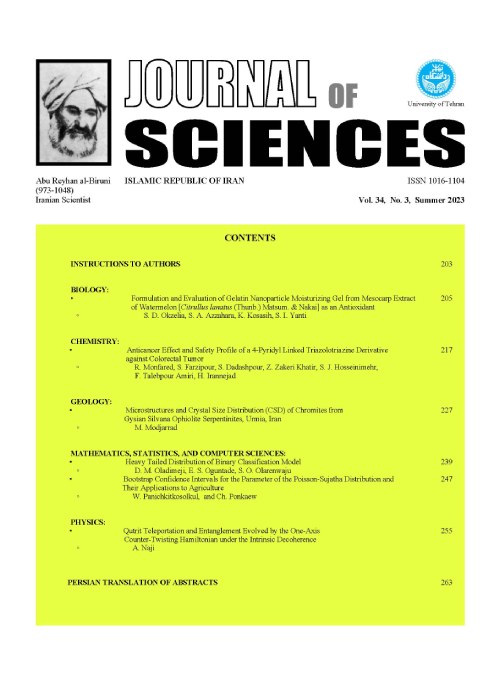فهرست مطالب

Journal of Sciences, Islamic Republic of Iran
Volume:21 Issue: 3, Summer 2010
- تاریخ انتشار: 1389/07/10
- تعداد عناوین: 9
-
-
ژئو شیمی عناصر اصلی، جزئی و نادر خاکی در نهشته بوکیت پرمو - تریاس بیگلر، شمالغرب آبگرم، استان قزوین، ایرانصفحه 225
-
صفحه 259
-
Page 205Photosynthetic characteristics and induction of crassulacean acid metabolism (CAM) by drought stress were investigated in Sedum album, Sedum stoloniferum and Rosularia elymaitica from Crassulaceae. Titratable acidity, malate content, phosphoenolpyruvate carboxylase (PEPC) activity and gas exchange parameters were determined in plants at the end and beginning of the photoperiod. Results showed that, significant changes in dusk/dawn titratable acidity (?Acidity) and malate (?Malate) could be detected in all three studied species after 20 days drought stress. However,? acidity and? malate in leaves of Sedum stoloniferum and R. elymaitica were less than values obtained for S. album. Although drought stress caused a significant increase in the activity of PEPC in all three studied species, difference between daytime and nighttime PEPC activity was significant only in S. album. In S. stoloniferum and R. elymaitica, despite of an increase by drought stress, net nighttime CO2 assimilation was still negative resembling a C3-like pattern of gas exchange. Comparison of responses of S. album with other two tested species showed that, drought stressed S. stoloniferum and R. elymaitica develop a low degree of CAM activity e.g. CAM-cycling metabolism, while S. album is capable to exhibit a typical CAM pathway under drought stress e.g. C3-CAM intermediate. Activity of superoxide dismutase and catalase were decreased under drought stress, but that of peroxidase and ascorbate peroxidase did not change. The exception was an increase in peroxidase activity in drought stressed R. elymaitica, suggesting an important role for this enzyme in the protection against ROS in this species.
-
Page 213A total of 40 samples from carbonates and 8 samples from silicate rocks were analyzed from the Sangan iron skarn deposit to examine behavior of the oxygen and carbon isotopes. The higher values of? 18O are from metamorphic calcite and dolomite and lower ones are from granitic rocks. Although the? 18O and? 13C values of calcite and dolomite in marble yield the highest values in the Sangan deposit, they are still lower than those of normal marine limestone and dolomite, i.e., reflecting coupled decarbonation and infiltrative metasomatic effects. The? 18O and? 13C values of calcite from the Sangan deposit show a progressive, gradual depletion from least-altered marbles into proximal skarn. The gradual decrease of the? 18O and? 13C values from metamorphic calcite to skarn calcite and dolomite can be ascribed to interaction of hydrothermal fluids with carbonate rocks in the area with an increase of water to rock ratio. The isotopic mass-balance calculations suggest the presence of magmatic water in the Sangan deposit.
-
Geochemistry of Major, Trace, and Rare Earth Elements in Biglar Permo-Triassic Bauxite Deposit, Northwest of Abgarm, Ghazvin Province, IranPage 225Biglar Permo-Triassic bauxite deposit is located in ~15 km northwest of Abgarm, southwest of Ghazvin province, west of central Iran. It consists of 8 stratiform and discontinuous bauxite lenses lying along the contact of Ruteh (Permian) and Elika (Triassic) carbonate formations. Petrographically, the bauxite ores exhibit collomorphic-fluidal, pseudo-breccia, pseudo-porphyritic, panidio-morphic-granular, nodular, and skeletal textures indicative of authigenic origin. Weathering of andesitic parent rocks led to the formation of Ferruginous laterite, bauxitic clay, and siliceous bauxite. Mass change calculations of elements indicate that Si, and Ba were depleted during bauxitization and Al, Ti, Zr, Nb, Hf, Ga, U, Th, V, and Cr were enriched. However, Fe, Y, Rb, Sr, Co, Ni, LREEs, and HREEs experienced leaching-fixation mechanism during the development of the residual system. Based upon obtained data, the available organic matters, pH variations in weathering solutions, adsorption process, functioning of carbonate bedrock as a geochemical barrier, existing in resistant minerals, and fixation in the neomorphic phases have been shown to play significant role in distribution of trace and rare earth elements. Further geochemical considerations indicate that minerals such as monazite, rhabdophane, belovite, churchite, and xenotime are the potential hosts for rare earth elements in Biglar bauxite deposit.
-
Page 237A sequence of Permian rocks crops out in Northwest of Khur in Central Alborz, North of Iran. This sequence consists of the Dorud (Asselian-Sakmarian), Ruteh (Artinskian-Murgabian) and Nesen (Early Djulfian) formations. The Ruteh and Nesen formations in Alborz Range were deposited in a shallow marine environment of the continental margin in the Paleo-Tethys. The Ruteh Formation with a thickness of 221m unconformably overlies the Dorud Formation and consists of fossiliferous limestones. This formation in the studied section can be subdivided into three informal members and overlain disconformably by the Nesen Formation (Early Djulfian). This sequence is disconformably overlain by the Elikah Formation (Scythian-Ladinian). The rich foraminiferal fauna indicates an Artiniskian to Early Djulfian age of the succession that can be established with the Schubertella-Mesoschubertella Assemblage Zone (Artinskian), Dunbarula-Deckerella and Neoendothyra-Pachyphloia Assemblage zones (Murgabian), and Paraglobivalvulina-Ichtyolaria Assemblage Zone (Early Djulfian).
-
Page 251The objective of this study was to develop a new optimal parallel algorithm for matrix multiplication which could run on a Fibonacci Hypercube structure. Most of the popular algorithms for parallel matrix multiplication can not run on Fibonacci Hypercube structure, therefore giving a method that can be run on all structures especially Fibonacci Hypercube structure is necessary for parallel matrix multiplication. For creating this method, a new model for matrix multiplication with an algorithm for data distribution on Fibonacci Hypercube structure was provided. Other than this, another optimized algorithm was designed on Mesh structure. By running the algorithms on a simulative parallel system and giving the results in graphical mode, it has been found that these two algorithms have optimized value in parallel matrix multiplication and they are more efficient than the previous algorithms.
-
Page 259Based on recent studies by Guy Jumarie [1] which defines probability density of fractional order and fractional moments by using fractional calculus (fractional derivatives and fractional integration), this study expands the concept of probability density of fractional order by defining the fractional probability measure, which leads to a fractional probability theory parallel to the classical one. According to the probability principles in classical probability theory and the definition of probability density of fractional order by Guy Jumarie, at first, the fractional probability principles are discussed. Then the fractional probability space is introduced. Consequently, the fractional probability measure, is explained. Moreover, validity of the classical "probability measure continuity" theorem () for the fractional probability measure is verified, which results in "Fatou Lemma" and some theorems in convergence concept.
-
Page 265In descriptive statistics, there are two computational algorithms for determining the variance S2, of a set of observations: Algorithm 1: S2= -, Algorithm 2: S2=, where. It is interesting to discuss, which of the above formulas is numerically more trustworthy in machine numbers sets. I this paper, based on total effect of rounding error, we prove that the second Algorithm is better than the first Algorithm. Numerical experiments show the efficiency of Algorithm 2.
-
Page 273
In this study, the nonlinear optical properties and optical limiting performance of the silver nanoparticles (AgNPs) in distilled water are investigated. The nonlinear absorption coefficient of the colloid is measured by the Z-scan technique. The optical limiting behavior of the AgNP suspension is investigated under exposure to nanosecond laser pulses at 532 nm. The results show that nonlinear scattering can increase the performance of the optical limiting. A theoretical analysis is suggested investigating the observed nonlinear behavior of the AgNPs. It will be shown that nonlinear light scattering occurs at high beam intensity due to induced refractive mismatch between the silver nanoparticles and water. The experimental Z-scan data is fitted with the proposed theoretical model and this has allowed extracting the values of nonlinear absorption coefficient, linear and nonlinear scattering coefficients for the AgNP suspension.
-
Page 279In this paper, we study the plasmonic thermal conductance of ordered stacks of metallic nanorings in a host material. Using second quantized formalism of the Random Phase Approximation, we first determine the dispersion relations of surface plasmon waves on the stacks of nanorings. Then, using Landauer-Buttiker formalism, we determine the coefficient of plasmonic thermal conductance and heat current through the stack as a function of temperature, radius, spacing of rings and dielectric constant of host material. Our results indicate that ordered stacks of metallic nanorings have potential plasmonic thermal properties for heat transfer in nanostructures.


